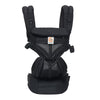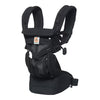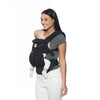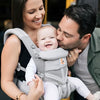Your baby will be snug as a bug in a high-quality baby carrier from Metro Baby! Discover the best baby carriers from leading brands like Ergobaby and Baby Bjorn. Find sophisticated designs that ensure comfort and safety for your newborn, infant or child. Shop for carriers, sling packs and wraps from Australia’s favourite online baby boutique, Metro Baby.







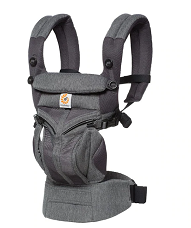
Top Baby Carriers For 2024
Babywearing is a modern term that describes carrying a baby close to your body in a sling or another type of carrier. At Metro Baby our carriers help you to carry your little one hands-free while taking the pressure off your arms and back. Our research will help you choose the right carrier for you in 2024.
read guideKeep baby close and your hands-free with a baby carrier
Holding your baby and having a cuddle is a special and enjoyable bonding experience. Yet, unfortunately, it does prevent you from doing almost anything else. A baby carrier offers your little one the physical closeness they crave whilst allowing mum and dad the freedom to move about.

Benefits of a baby carrier
Baby carriers allow parents to keep their little one close and their hands free, which can be a lifesaver. Choose a baby-wearing device to keep bub close while enjoying the flexibility of walking, folding laundry, making lunch or grocery shopping. Baby carriers assist by:
● Giving a caregiver the freedom to travel without a stroller, which makes simple outings such as walking with a friend much easier.
● Offering a great way to bond with your little one, especially for dads who naturally don't get as much physical closeness.
● Protecting baby from prying eyes or hands and helping reduce overstimulation.
● Helping to soothe your baby means they spend less time crying. Instead, they will spend more time in a calm, learning state in which they can enhance their cognitive development.
● Enabling discreet breastfeeding.
● Benefiting baby’s physical health and development by preventing "flat head syndrome", helping develop muscle groups used to balance and improving digestion by being kept upright.

Different designs available
Based on your little one’s age, budget, the carrying position you desire, and the ease of use you require, a few different design options are available.
● Soft structured carrier: This style is what most people think of when they think of a carrier. The ergonomic design is straightforward, with adjustable padded shoulder straps and a waistband.
● Baby sling: A simple carrier composed of a single piece of fabric and a ring that rests on one shoulder across your body. It can be positioned on your chest or hip for flexible carrying positions.
● Wrap carrier: A more complicated carrier to master, a wrap is a single piece of fabric tied around your body to hold the baby.
● Back carry or backpack: Only suitable for older babies who can sit unassisted, support their head and have good neck control.

Choosing the best baby carrier for you
There are a few things to consider when searching for the best carrier for your baby:
● Your baby’s age and weight.
● If you want a light, compact carrier to travel with or are happy with a bulkier, more supportive version.
● The amount you wish to spend.
● Your preferred position and the direction you’d like to have your baby facing.
Forward-facing vs rear-facing carriers
Forward-facing carriers are the more common carrier and are widely regarded as the safer option for a baby. For the first few months of a baby’s life, they are very happy to be facing in, nestled into mum or dad’s chest in a womb-like environment. As they grow, they will become more interested in the world around them. However, they must be at a specific developmental stage to safely sit in an outward-facing carrier.
Rear-facing carriers risk not adequately supporting the baby’s legs, hips, spine, head or neck. The position may hurt the wearer’s back, overstimulate your baby and make it harder to respond to your baby’s cues without viewing their face. Rear-facing carriers are only appropriate for babies at least six months old. Your baby must have enough neck strength to support their head and be tall enough that their chin sits above the carrier’s top. If these conditions are met, outward-facing carriers are generally safe for short periods. However, if your baby is not eager to be outward facing, keeping them in an inward-facing carrier is best.

Carriers safe for newborns
A newborn baby is safe in a carrier designed specifically for their age and weight. If you’d like your carrier to be used past the newborn stage, consider buying a brand and model with an infant insert to help extend the carrier’s usability.
Hands-free
One of the perks of a baby carrier is that it allows a parent to be hands-free and gives mum or dad the flexibility to do other things while keeping bub close.
Adjustable straps
Adjustable straps are fundamental to keep a baby securely fastened and the wearer comfortable.

Soft structured
Soft-structured baby carriers have enough support to help secure your baby in the proper position. This style is made from breathable fabrics that facilitate airflow to help regulate your baby’s temperature.
Straps and waist belt
Straps and waistbands help protect your back, secure bub to in position, distribute the baby's weight evenly and enable you to change your carry position easily.
Padded shoulder straps
Broad, extra cushioned, comfy shoulder straps are essential to help distribute weight evenly and keep the wearer comfortable.

Head support is always important
When using a baby carrier, always ensure that the baby’s head and neck are properly supported.
Carriers for older babies
To accommodate older babies, either buy a carrier designed to grow with your baby from newborn to toddler or buy a backpack-style carrier that’s safe to use with toddlers. Multi-purpose backpacks are great for adventures, functioning as carriers, nappy bags and pram bags all in one.
Difference between a baby carrier, sling and a baby wrap
A baby carrier is a structured design (with lumbar and shoulder support) that’s worn on a parent’s back, front or hip and secured with straps and buckles that attach around the wearer’s back and waist.
A baby sling is a pouch or strip of fabric secured over the wearer’s shoulder and across the torso.
A baby wrap, like a sling, is also composed of a single piece of fabric, conforms to the adult’s body and is lightweight. Wraps are more complicated to use, with a variety of ways to wrap and position your baby. A wrap is usually worn over both shoulders and tied around the waist to distribute weight evenly.

Baby safety is most important
When using a baby carrier, safety is essential. Safe hip positioning and the right support are critical. To prevent hip dysplasia, ensure your carrier holds your baby in a seated “M” position with knees tucked up higher than the baby’s hips.
Additionally, your carrier should be constructed of breathable 3D mesh or cool air mesh fabric to keep the baby warm but not overheat.
Brands we know and trust
Bestsellers like BabyBjorn, Ergobaby, Lillebaby, Moby and Baby K'tan are all high-quality, trusted and well-loved brands. Some of the popular styles include:
- The Baby Carrier One Air -Breathable, lightweight all-mesh carrier that dries quickly.
- Alta Hip Seat Baby Carrier - Hands-free carry and an assisted one-hand hold, all in one.
- Ergobaby Omni 360 - Breathable, lightweight, all-mesh carrier with four carry positions.
- Ergobaby Omni breeze - A multi-position padded lumbar carrier with maximum airflow.
- The Aura Wrap - A simple, lightweight, supportive wrap with a built-in pouch.
Buying a baby carrier online with Metro Baby
Shop Metro Baby today to find the best baby products in Australia, from baby carriers, prams and car seats to bibs and swaddles.
Frequently Asked Questions (FAQs) About baby carriers:
Which is the best baby carrier?
Look for a quality and trusted brand that meets Australian safety standards and is appropriate for your baby’s age and weight and you are on the way to finding the right carrier. Ergobaby and Baby bjorn baby carriers are some of the most highly regarded on the Australian market.
What makes a good baby carrier?
A good child carrier is well-designed, safe, easy to use, comfortable for both the baby and the wearer and built to last. Once you have found your perfect baby carrier, add it to your gift registry, and you might receive it at your baby shower!
How long do babies use infant carriers?
Some babies use carriers up to age 2, while others outgrow them after six months or a year. How long your baby uses a carrier ultimately depends on how much they like it. Like prams and car seats, you’ll need to ensure your carrier is still suitable for your baby’s size and weight as they grow.
How long can a newborn be in a carrier for?
In general, limit a baby’s time in a carrier to one hour at a time to give his or her hips a break. If you have more questions about baby carriers, please contact one of our helpful customer service members today.























































































































